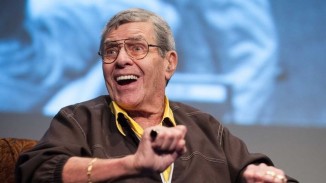184 years ago today, Shibusawa Eiichi was born in Japan. Known as “The Father of Japanese Capitalism” this economist and industrialist introduced Western free market capitalism into the melting pot of Western policy and Eastern values that became the Meiji Restoration. Double log accounting, joint stock companies, a chamber of commerce, and modern note-issuing banks, are all present in Japan today according to Shibusawa’s vision, and many of the fine products that came out of Japan during the 20th century did so because Shibusawa had helped fund them. LEARN about his massive impact on the Japanese economy… (1840)
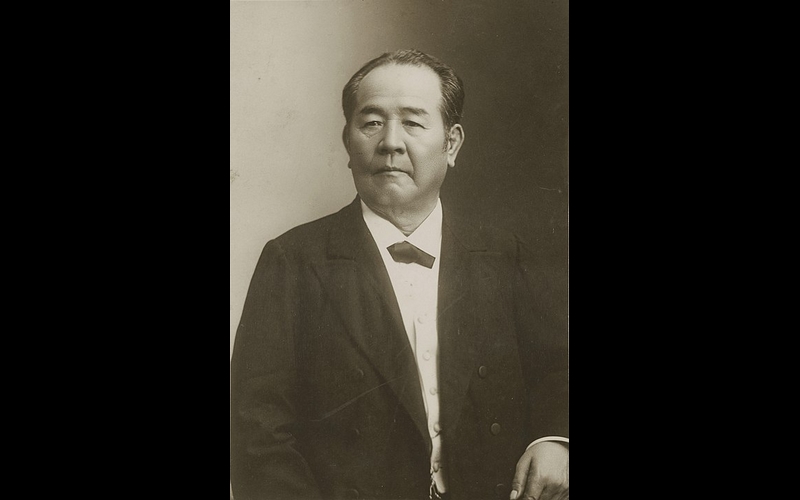
As a youth, Eiichi almost became a domestic terrorist with a plot to set fire to a local castle, but instead moved to Kyoto. Observing the Universal Exposition in Paris in 1867, he returned from Europe at the news of the change of governments now known as the Meiji Restoration, and established the Shōhō Kaishō, one of the first joint-stock companies in Japan.
In 1873 Shibusawa became the president of the Dai-ichi Bank (First National Bank). This was Japan’s first modern bank. He believed that business needed strong ethics, which might sound obvious, but a walkthrough of some of the many companies Dai-ichi Bank helped start demonstrates that many of these are still quoted on the Tokyo Stock Exchange today, epitomizing the value of his belief, and his Warren Buffet-like eye for potential.
These include Mizuho Financial Group, The 77 Bank, Tokio Marine Nichido, Imperial Hotel, Tokyo Stock Exchange, Tokyo Gas, Toyobo, Tokyu Corporation, Keihan Electric Railway, Taiheiyo Cement, Oji Paper Company, and Sapporo Breweries. Like wealthy industrialists in America, he poured his fortune into education, social welfare, and other causes, totaling over 600 philanthropic endeavors.
Despite all this wealth, he never owned controlling stakes in any of the companies he invested in so as not to disrupt the key factors that made them successful in the first place. Nominated for the Nobel Prize in 1926, he is due to be printed on the 10,000 yen note this year.
MORE Good News on this Date in History:
- The British surgeon Joseph Lister first published his discovery of antiseptic surgery, applying Louis Pasteur’s advances and successfully introducing carbolic acid (now known as phenol) to sterilize surgical instruments and clean wounds, which became the first widely used medical antiseptic (1867)
- Marshal Tito of Yugoslavia visited London in friendship, the first Communist leader to do so (1953)
- The first space docking: Gemini 8 with Agena (1966)
- Russian space station Mir welcomed the first American aboard (1995)
- Coordinated worldwide peace vigils were held in 100 countries and in more than 6,000 locations, in response to the war in Iraq (2003)
- The UN General Assembly overwhelmingly voted to establish the UN Human Rights Council (2006)
- The palace at Bronze Age Knossos, home of the legendary Minotaur, was rediscovered on the island of Crete by Sir Arthur Evans (1900)
185 years ago, John Butler Yeats, Irish painter and father to famous author William Butler Yates, was born in the County Down. Without becoming world-renowned, Yeats never had issues getting commissions, we know because of the large number of paintings but especially sketches that hang in houses around Ireland, England, and the US.
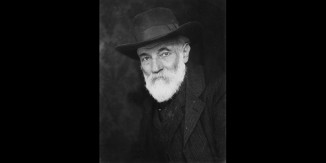
The National Gallery of Ireland holds many of his paintings, most of which are portraits that show great sensitivity to the sitter. The Butler Yeats family was highly artistic; his son Jack became an esteemed painter, and obviously, W. B. Yeats became the central force of the Irish literary revival. John’s daughters Elizabeth and Susan Mary became involved in the Arts and Crafts movement. (1839)
152 years ago today, the English FA Cup was lifted for the first time. The oldest knockout competition in association football remains a highly desired prize and was first won by Wanderers F.C. (football club). 151 years later, and Wanderers compete in the 12th level of the English Football League System.
The FA Cup is unique among European domestic knockout cup competitions in that it includes hundreds of teams, down to the 10th level of the English football pyramid, which is the equivalent of 6 steps below Single-A baseball in America, if such a thing existed. As such, the weekends when English teams play in the FA Cup are widely celebrated as honoring the truest spirit of sportsmanship. (1972)
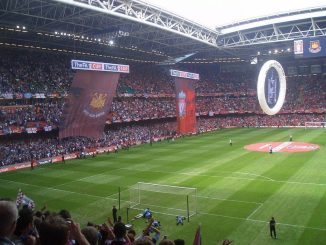
Hereford 2 — Newcastle United 1
50 years ago, there was a replay of a Third Round match between Hereford and Newcastle which ended in a 2-2 draw, despite the fact that four tiers of the league pyramid, which is equivalent to around 80 teams, separated the two clubs. Newcastle were competing regularly in European competition, while most of the players at Hereford in the south of England near the border with Wales, were not even full-time professional footballers.
The 14,000-seater Hereford park was thought to have 16,000 in it. People were filmed sitting in trees to watch, and the BBC sent out a novice 26-year-old commentator named John Motson as part of a work trial. Newcastle were leading after half-time when a carpenter named Ronnie Radford booted in a screaming equalizer, which won Goal of the Season on the BBC, who incorporated his celebration into the opening video of Match of the Day for years to come.
Wrexham 2 — Arsenal 1
Another 50-years-ago giant killing came when Wrexham, a club recently bought by American actors Ryan Reynolds and Rob McElhenny, situated in the old Fourth Division, now Fifth Division, came up against London’s Arsenal. More than half of the Wrexham team were aged 20 or under, meanwhile, Arsenal were on top of the country: defending First Division and Community Shield winners, and the following year they would win both the FA Cup and League Cup.
Nevertheless, the Welsh minnows reminded them of the price you pay for walking onto a football pitch without sufficient desire to battle for 90 minutes. (1872)
WATCH other “giant killing” moments when tiny teams topple top teams…
98 years ago today, Dr. Robert Goddard launched the world’s first liquid-fueled rocket, after building it himself.
The New England physics professor, engineer, and inventor is credited with ushering in the era of space flight, but after he asserted in 1920 that rockets could be used to send payloads to the Moon, he was thought to be absurd and mocked by the press, which called him “Moon Man.”
This ‘first flight’ took place at Auburn, Massachusetts, using liquid oxygen and gasoline as propellants. The rocket, dubbed “Nell”, rose just 41 feet, but it demonstrated that rockets utilizing liquid propulsion were possible, something Goddard proposed 15 years earlier. In the next 15 years, he and his team would launch 34 rockets to altitudes up to 1.6 miles (2.6 km) at speeds up to 550 mph (885 km/h).
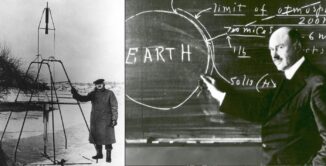
The Smithsonian published Goddard’s seminal paper A Method for Reaching Extreme Altitudes, which years later was recognized as marking the dawning of the Space Age—the same as the Wright Brothers flight did for air travel. Yet, the pioneer attracted little serious attention before he died in 1945, a decade before American rocket scientists discovered it was virtually impossible to construct a rocket or launch a satellite without acknowledging the work of Goddard. LEARN more… (1926)
He had 214 patented inventions, including a multi-stage rocket (1914), a liquid-fuel rocket (1914), as well the addition of two-axis controls (gyroscopes and steerable thrust) for rockets to effectively control their flight. In 1959, NASA’s Goddard Space Flight Center was named in the shy man’s honor.
And, on this day in 1621, Samoset visited the settlers of Plymouth Colony and greeted them saying, “Welcome, Englishmen! My name is Samoset.”
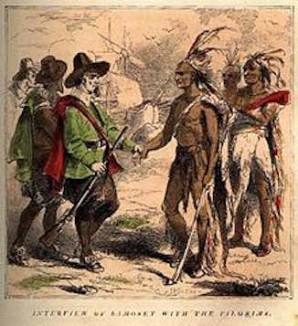 He was the first Native American to make contact with the Pilgrims, strolling right into their encampment and speaking English. An Abenaki tribe member from Maine, he had learned some words from the Englishmen who fished and made a camp on Monhegan Island.
He was the first Native American to make contact with the Pilgrims, strolling right into their encampment and speaking English. An Abenaki tribe member from Maine, he had learned some words from the Englishmen who fished and made a camp on Monhegan Island.
174 years ago today, The Scarlet Letter was published in Boston—one of the first mass-produced books in America, by one of America’s first authors Nathaniel Hawthorne.
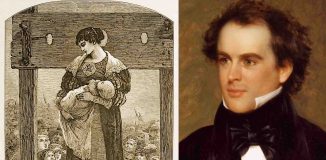
Set in 1640s Puritan Massachusetts, the novel tells the story of a young woman who conceives a daughter through an affair and then is required to wear a scarlet “A” on her chest and endure public humiliation for the rest of her life. Beautiful, with quiet dignity, she refused to name the father despite unyielding pressure.
Popular in its day, the book went on to earn a reputation as a masterwork of fiction. The Scarlet Letter inspired numerous film and stage adaptations and novelist D. H. Lawrence called it a “perfect work of the American imagination.” Hawthorne followed with a succession of books, including other romances, many short stories, and The House of Seven Gables. (1850)
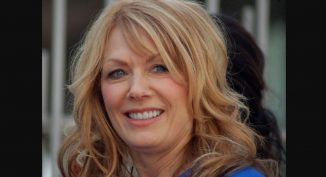
Happy 70th Birthday to Nancy Wilson, guitarist, and vocalist from the band Heart. Alongside her older sister Ann, the Seattle natives starred in the first ‘hard rock’ band fronted by women—and climbed the charts with their debut LP Dreamboat Annie in 1975, and Little Queen two years later. With songs like Magic Man, Crazy on You, and Barracuda, Heart sold over 35 million records. Nancy has been lauded for blending elements of flamenco and classical guitar styles into her hard rock—and Gibson ranked Wilson #8 on the greatest female guitarist of all time. (1954)
And, on this day in 1926, the great comedian, actor, writer, and charity champion Jerry Lewis, was born.
First known for his slapstick humor in film, television, stage and radio, Lewis also became the host, for more than 40 years, of the Muscular Dystrophy Association’s annual Labor Day Telethon and national chairman of the MDA, helping to raise more than 2.5 billion to help people with the neuro-muscular disease. WATCH a hilarious clip of highlights showcasing his physical comedy and famous friends, Dean Martin and Frank Sinatra…
Share the Milestones, Memories, and Music…




















